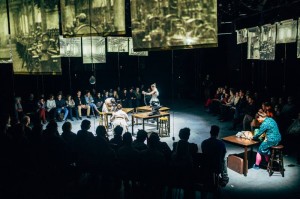 That last 2 years of my creative life have been dominated by an all-encompassing collaborative project, namely, the 3 Singer Opera. The work was officially commissioned by the Cleveland Ingenuity festival following the 2012 festival where we (we being Erica Mott Productions which is a loose consortium of creative artists headed up by the intrepid Erica Mott, a choreographer, director, and deviser I have been working with for the past 5 years
That last 2 years of my creative life have been dominated by an all-encompassing collaborative project, namely, the 3 Singer Opera. The work was officially commissioned by the Cleveland Ingenuity festival following the 2012 festival where we (we being Erica Mott Productions which is a loose consortium of creative artists headed up by the intrepid Erica Mott, a choreographer, director, and deviser I have been working with for the past 5 years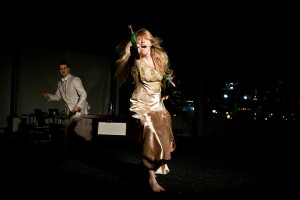 ) had just given the US premier of a Duet version of 2011’s the Victory Project with the participation of the amazing and gifted video artist John Boesche. John ha
) had just given the US premier of a Duet version of 2011’s the Victory Project with the participation of the amazing and gifted video artist John Boesche. John ha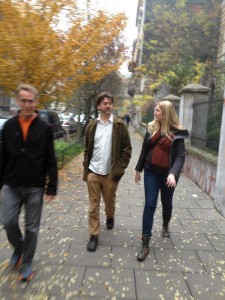 d been added to the mix on the recommendation of our friend, mentor, and in this case, Daramaturg, Ginger Farley. Though the official invitation to create the work came from the festival in 2012, we really had started talking about it long before that. Erica had been working with sewing machines as sculptural objects on stage a few years previously and had already conceptualized a piece in which 3 performers who embodied textile factory workers, especially those who died in the Triangle Shirtwaist Factory Fire of 1911, performed with the machines creating rhythmic structures and a constant pulse that grew and grew over the course of a performance length work. I was already getting excited about the possibilities for interaction and thinking of ways to harness the sewing machine to manipulate different aspects of sound on stage and at the same time was working with my compatriots Kyle Vegter and Dan Dehaan on our “Soundroom” project at High Concept Labs in Chicago. Soundroom was a project resulting in new concepts of how to use a space as a sound installation, but also how to imagine live electro-acoustic performance and improvisation. We built a sound installation space that could be performed in giving performers the ability to manipulate certain parts of the installation in a specific way. Through all of this, I was imagining different ways that performers on stage could manipulate their machines, that they were somehow virtually tethered to, in order to create a sense of metaphor for the machines control over the human body, or more precisely, the back and forth of development of technology to reflect human need and desire, tempered by the effect that technology has on the human body and psyche, creating a kind of socio-technological feedback loop. Of course, in this particular opera, we were looking more specifically at the way global trade effects one particular situation, that then migrates around the globe, namely, human desire for cheap clothing resulting in sweatshop labor conditions, first in our own back yard, then to central Europe, then south America, and now to Asia. But socio-political implications aside, I had to figure out how to get the motion of the sewing machines needle or speed of it’s motor translated into digital information that I could use to manipulate the human voice. I had a feeling I was going to need some cheap labor for this one.
d been added to the mix on the recommendation of our friend, mentor, and in this case, Daramaturg, Ginger Farley. Though the official invitation to create the work came from the festival in 2012, we really had started talking about it long before that. Erica had been working with sewing machines as sculptural objects on stage a few years previously and had already conceptualized a piece in which 3 performers who embodied textile factory workers, especially those who died in the Triangle Shirtwaist Factory Fire of 1911, performed with the machines creating rhythmic structures and a constant pulse that grew and grew over the course of a performance length work. I was already getting excited about the possibilities for interaction and thinking of ways to harness the sewing machine to manipulate different aspects of sound on stage and at the same time was working with my compatriots Kyle Vegter and Dan Dehaan on our “Soundroom” project at High Concept Labs in Chicago. Soundroom was a project resulting in new concepts of how to use a space as a sound installation, but also how to imagine live electro-acoustic performance and improvisation. We built a sound installation space that could be performed in giving performers the ability to manipulate certain parts of the installation in a specific way. Through all of this, I was imagining different ways that performers on stage could manipulate their machines, that they were somehow virtually tethered to, in order to create a sense of metaphor for the machines control over the human body, or more precisely, the back and forth of development of technology to reflect human need and desire, tempered by the effect that technology has on the human body and psyche, creating a kind of socio-technological feedback loop. Of course, in this particular opera, we were looking more specifically at the way global trade effects one particular situation, that then migrates around the globe, namely, human desire for cheap clothing resulting in sweatshop labor conditions, first in our own back yard, then to central Europe, then south America, and now to Asia. But socio-political implications aside, I had to figure out how to get the motion of the sewing machines needle or speed of it’s motor translated into digital information that I could use to manipulate the human voice. I had a feeling I was going to need some cheap labor for this one.
Then, on the CTA, a billboard advertising a call for projects for the Segal Institute of Design at Northwestern University. This was an entry level class in design for young engineering students where you could present a design issue you needed solving and a team of students would come and try to solve it. Thus, the 3 Singers sewing machine was born.
Engineering a Singer from Erica Mott on Vimeo.
A machine equipped with an infra-red sensor that simply tracked the motion of the thread arm of the sewing machine. Each time it passed by, a signal would be sent to my computer that I could use for multiple purposes. Sometimes triggering sounds, and sometimes cutting up the sound of the singers’ voice. An amazing project in its own rite, that class in the Spring of 2012 set the stage for what would be an 18 month experiment in human machine interaction (in a very literal sense).
But that was really just the tip of the iceberg in how this collaboration 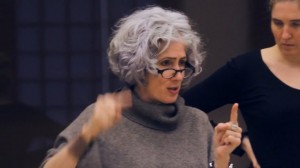 would evolve. Ladies and gentlemen, may I introduce to this blog, Fides Krucker. When talking about how we would go about developing the techniques that would be necessary, both in movement and sound, Erica and I realized that we would be asking singers to do very unconventional things and neither me or Erica had the specific training to help develop or cultivate such specific techniques. A friend of Erica’s in Toronto insisted we get in touch with Fides and after a quick skype chat from Iceland to Toronto (sorry, Iceland is for anther blog post that I should have done 2 years ago) we agreed that she would be the right fit.
would evolve. Ladies and gentlemen, may I introduce to this blog, Fides Krucker. When talking about how we would go about developing the techniques that would be necessary, both in movement and sound, Erica and I realized that we would be asking singers to do very unconventional things and neither me or Erica had the specific training to help develop or cultivate such specific techniques. A friend of Erica’s in Toronto insisted we get in touch with Fides and after a quick skype chat from Iceland to Toronto (sorry, Iceland is for anther blog post that I should have done 2 years ago) we agreed that she would be the right fit. 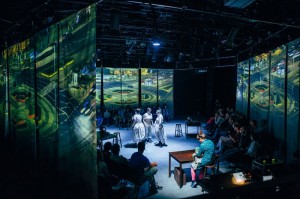
It is tempting here to just tell the story of how this entire project developed, and it would be a long story with many details. More in fact, than I can possibly remember. As I pore over notebooks I realize that I could have likely used a personal video documentarian over the past 2 years to follow me around and document each moment so I could later remember what chickens came before what eggs, and exactly who laid them. Because in fact, this is not a work that I can take full credit for as a composer, even though my name appears by the word “composer” in quite a bit of the information going around out there in the world at the moment. So in this blog post, I am going to try to give my impression of how this work was created and who is responsible for it. Call it a memoir of a new collaborative practice. One in which even though I cannot claim full credit as composer, I am likely even more proud of than those efforts that I can claim full responsibility, for it was hard earned, and in the end, has the richness of many artistic minds working in tandem while, according to many, seeming like something one person set out to create and planned out from beginning to end. An accomplishment I think any artist should be extremely proud of in itself.
Every Opera (or Ballet piece) is a collaboration between different artists. There are librettists, poets, directors, dramaturgs, choreographers and set designers all working together to create one work, but in the end, usually it is the composer whose name is attached to such a work for posterity sake. The same is often true of works for the ballet stage. After all, you rarely hear about Nijinsky’s “Rite of Spring” or Cocteau’s “Oedipus Rex”, even though it is clear that those two artists had an essential role to play in the outcome of the Stravinsky’s musical scores. 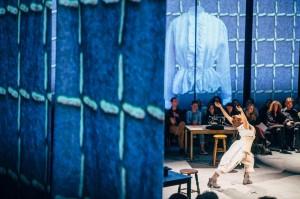 But in general, a differentiation can be made in these cases as despite the effect the narrative structure of these works had upon the eventual musical score, the music itself was purely the work of Stravinsky. Now fast forward 100 years, where multi-media work abounds, improvisation has made a comeback into musical form, and often times artists from different disciplines work together to create a work of art where one part depends on the other. Erica and I have been calling this “inter-dependent” performance and compositional practice but I am sure there are many different ways of referring to it out there.
But in general, a differentiation can be made in these cases as despite the effect the narrative structure of these works had upon the eventual musical score, the music itself was purely the work of Stravinsky. Now fast forward 100 years, where multi-media work abounds, improvisation has made a comeback into musical form, and often times artists from different disciplines work together to create a work of art where one part depends on the other. Erica and I have been calling this “inter-dependent” performance and compositional practice but I am sure there are many different ways of referring to it out there.
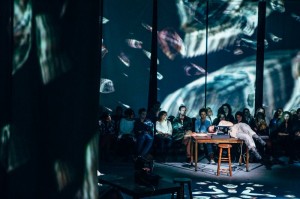 We feel like our methods are fairly unique to how we work together. I had been looking for a collaborator like Erica for years and had found it in only a rare few musicians who were willing to go on a journey with me outside of the usual business model established by the classical music world. I found it for years in my collaboration with Jason Wampler (We Can and We Must) and then, on occasion with my sisters and brothers in Assemblage (Charles Waters, Andrew Barker, Shannon Fields), and the 12 Dimension Plane of Sound And Vision Orchestra (Shannon Budd, Erica Dicker, and Dan Peck) where musicians would dive head first into a process of mutual creation. In We Can and We Must, Wampler and I tried to find points of intersection where we were both creating one sound together as one mind. Weather it being morphing two sounds that we were controlling together or by one of us manipulating the sound the other was making live, there were many moments where we literally started becoming unaware of ourselves as individual musicians and would feel as if we had one mind with four hands and two voices. In assemblage and 12 Dimension Orchestra, I created a sound environment that would transform over the course of an improvisation giving my fellow musicians the score in real time in the form of audible feedback from their instrument and various combinations of instruments. The closest I have come to actually smelting live sound in a room. But given the intermittency of the latter two collaborations and the departure of Wampler for China in 2008, I was searching for a new direction.
We feel like our methods are fairly unique to how we work together. I had been looking for a collaborator like Erica for years and had found it in only a rare few musicians who were willing to go on a journey with me outside of the usual business model established by the classical music world. I found it for years in my collaboration with Jason Wampler (We Can and We Must) and then, on occasion with my sisters and brothers in Assemblage (Charles Waters, Andrew Barker, Shannon Fields), and the 12 Dimension Plane of Sound And Vision Orchestra (Shannon Budd, Erica Dicker, and Dan Peck) where musicians would dive head first into a process of mutual creation. In We Can and We Must, Wampler and I tried to find points of intersection where we were both creating one sound together as one mind. Weather it being morphing two sounds that we were controlling together or by one of us manipulating the sound the other was making live, there were many moments where we literally started becoming unaware of ourselves as individual musicians and would feel as if we had one mind with four hands and two voices. In assemblage and 12 Dimension Orchestra, I created a sound environment that would transform over the course of an improvisation giving my fellow musicians the score in real time in the form of audible feedback from their instrument and various combinations of instruments. The closest I have come to actually smelting live sound in a room. But given the intermittency of the latter two collaborations and the departure of Wampler for China in 2008, I was searching for a new direction.
Erica invited me to work with her on the Victory project and in 2011 we premiered the full company version at Northerly Island which featured several duet pieces that involved just her and I as performers. At first, I played my usual role of working off stage while she interacted with the sound on stage. Working with a Theremin attached to her body and a desk wired for sound where impacts against the desks surface would generate noise as well as triggering sounds. But then it became apparent that what we were doing had such a physical connection with me often prompting her to motion and her movement so often prompting me to reaction, she decided we needed to both be characters on stage. So I moved my setup to the back of the stage and she begin to give me choreographic instructions which eventually led to me being a “dancer” in the piece while simultaneously running the interactive patches that played and manipulated all the sound in the piece. Though I tried to follow instruction as much as I could during this process, there were times where I had to adjust the choreography for practical reasons as I could not physically do the things I needed to do performatively and also manage the choreography. At other times I would just find that I had a desire to hear something behave differently musically which then affected the way I would move. 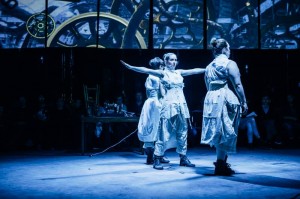 This fact at first was frustrating but once we realized that it was in response to the sound that my movement was most convincing, we ended up going with that as the driving force for my choreography. On the inverse of that, from the beginning, when Erica began to experiment with the “War Desk” (the desk that would explode with sound and visual response when she would throw herself against it) there was a constant back and forth regarding the content of the sound as well as the character of the movement including the rhythm of certain gestures, how the desk was struck, tapped, nudged, and what kind of materials were used to do said tapping and hitting. We would also experiment with different reactions and manipulations to the sound. In this way, Erica’s movement score would essentially create the live sound score simultaneously. Through this trial and error process, we would eventually develop a structure for a piece that had some room for in the moment improvisation but was ultimately the work of both Erica and I together. Though I had musical ideas that I presented, and Erica had movement and narrative materials she presented, the WAY these materials eventually appear in the piece is collaborative. So we in the end were both 50/50 composers and choreographers (or some other percentage thereof), rather than just one reacting to the others work after the fact.
This fact at first was frustrating but once we realized that it was in response to the sound that my movement was most convincing, we ended up going with that as the driving force for my choreography. On the inverse of that, from the beginning, when Erica began to experiment with the “War Desk” (the desk that would explode with sound and visual response when she would throw herself against it) there was a constant back and forth regarding the content of the sound as well as the character of the movement including the rhythm of certain gestures, how the desk was struck, tapped, nudged, and what kind of materials were used to do said tapping and hitting. We would also experiment with different reactions and manipulations to the sound. In this way, Erica’s movement score would essentially create the live sound score simultaneously. Through this trial and error process, we would eventually develop a structure for a piece that had some room for in the moment improvisation but was ultimately the work of both Erica and I together. Though I had musical ideas that I presented, and Erica had movement and narrative materials she presented, the WAY these materials eventually appear in the piece is collaborative. So we in the end were both 50/50 composers and choreographers (or some other percentage thereof), rather than just one reacting to the others work after the fact.
The Victory Project (Touring Version) from Erica Mott on Vimeo.
With 3 artist engaging in this back and forth, things got more complex, but also much more interesting. The first time I actually met Fides in a room, and I applied microphones to the singers to have them first work with electronic manipulation of the voice, she said the 5 words that always make me cringe both as an electronic musician/composer and a sound engineer. “I don’t really like microphones”. My heart just about stopped. Here I was, going to embark on an extremely ambitious project dealing with the most sensitive instrument and situation you will ever deal with, that being the human voice, and the person I was going to be working with to get us through this delicate situation had just announced that they did not much like, pretty much everything I knew I was going to be trying to do to the voice and to the singers! Reflecting back now on those 5 words, I realize that the journey we were about to embark on, and one I am so happy we all stuck with, likely could not have begun any other way.
3 Singers: A Day In The Process – Fides Krucker from Erica Mott on Vimeo.
3 Singers (Teaser 3) from Erica Mott on Vimeo.
It would be a journey of discovery for all of us about what happens to the human voice when it is first given years of social and emotional conditioning (which I learned over the course of working with Fides is true not just for the female voice but also the male voice, but in very different ways), as well as what happens to the human voice when it hears itself in different contexts, especially when amplified and projected into a space. It forced me to really consider every assumption I had made about how everyone hears themselves when amplified or manipulated in some way and how to get other musicians, and especially singers, to hear, think, and feel the things I think and feel when performing in this way after having developed personal techniques over the course of 15 plus years as an electronic performer. In short she challenged me to re-consider how I thought of the interactive process, not just for vocalists, but for all types of performers, and in the process, gave me a whole new vocabulary through which to communicate the “technique” of interactive performance as it applies to my music and electronic techniques.
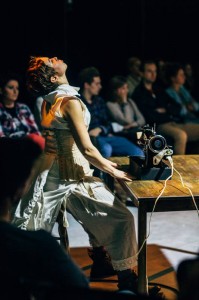 I came into the situation, really feeling the strain of having to develop new techniques and teach singers how to do the things I wanted them to, and what I learned from working with Fides and Erica on this project is how to discover what was already inside them. In fact, this process of devising is essential to the work that they have both done for the last many years. So, after many failed attempts to impose different processes or techniques onto the situation, I began to just listen. To approach the work with the same collaborative spirit I had approached Victory Project with and see where things went.
I came into the situation, really feeling the strain of having to develop new techniques and teach singers how to do the things I wanted them to, and what I learned from working with Fides and Erica on this project is how to discover what was already inside them. In fact, this process of devising is essential to the work that they have both done for the last many years. So, after many failed attempts to impose different processes or techniques onto the situation, I began to just listen. To approach the work with the same collaborative spirit I had approached Victory Project with and see where things went.
3 Singers (Teaser 1) from Erica Mott on Vimeo.
So in general, a giant pool of research was done by 3 artists and we each interpreted, discovered new tidbits, read different books, and shared our thoughts with one another. At times I would do my composerly “draft sketch” kind of thing to see if there was any resonance with the other artists and at other times I would just do small sketches of short sections. Often the ideas for these would come from Erica’s research, but at other times, it would be the result of material that Fides would develop in collaboration with the individual performer. For instance, each Singer in the Opera has a kind of “totem bird” that their character takes certain cues and direction from at certain points. Erica had the idea to give them this and worked with them in movement based on videos and recordings of these birds and then Fides had them kind of “notate” in their own shorthand a slowed down version of the bird so they could kind of create their own “human” version of the song, then I later decided to use these slowed down bird songs as a basis for a notated melody (I know, Messian already did that. Whatever) but all in the same key that then became actual “baroque” style Arias I wrote but that were further manipulated and stylized by Fides and whose presentation was choreographed by Erica. Then ideas of how to present and structure them in and amongst a factory setting in juxtaposition with physical portraits of the dancers relationship with a sewing machine were thrown around and more ideas about how these arias might return in the space later in the piece and how the clavichord accompaniment was reminiscent of the sewing machine (intentional on my part) so we should perhaps have the accompaniment kind of “duet” and switch off with the sewing machine performances. It was like how George Martin describes later sessions of The Beatles once they became a studio band. Everyone’s ideas were tried out. Some ideas flopped, but sometimes those flops led to more ideas. After a time, we learned each other’s languages well enough that we learned how to request something form one another’s realm without stepping on each other’s toes.
3 Singers (Teaser 2) from Erica Mott on Vimeo.
This is not to say that I became a vocal guru or Fides developed a full grasp of technical lingo or how a mixing board worked. That is not the point. The point is that we reached a consensus on what things meant and more importantly, we developed a TRUST between one another that allowed us to let our guard down as artists and professionals. We became close enough as collaborators that we were all allowed to say something stupid, all allowed to fail, and all allowed to say that we understood someone else’s idea but just could not do what the other wanted that particular day. No idea was disregarded. And THAT to me is the really important thing about this kind of collaboration. Developing that trust.
But that trust was not cultivated and achieved by just the 3 of us. There were many others who lent an outside eye to the work. First, there was Ginger Farley. Ginger offered to be Dramaturg but also general spiritual mentor for the work. Without her coming in with an objective perspective every month or so, and without her amazing “postit” charts summarizing the structure of the piece she was seeing formulate in disparate chunks before her, we would likely have never had the clarity to make it to the finish line. It was also very much her research that helped us decide what we were trying to say with the work and was her level head and voice of reason that got us through our most trying moments. 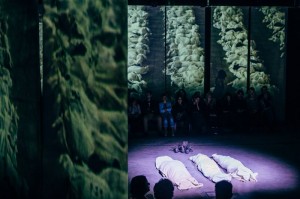 Then there was John Boesche who was watching from afar most of the process to develop some spectacular video material but who also provided a steady professional perspective whenever we were getting lost in the process. His work projected onto the set (designed by Architect Leigh Breslau and stage and lighting designer Todd Clark) really gives the work its complete form.
Then there was John Boesche who was watching from afar most of the process to develop some spectacular video material but who also provided a steady professional perspective whenever we were getting lost in the process. His work projected onto the set (designed by Architect Leigh Breslau and stage and lighting designer Todd Clark) really gives the work its complete form.
Of course, when talking about a collaborative piece where materials are developed on particular performers, we can’t help but mention the performers as well. And in fact, in this case, we had 7 different performers train for the 3 roles, some of whom had intended to only help us through the development process, but wh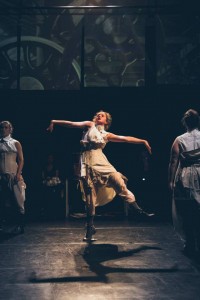 ose contribution should not be under stated. Jenna Lyle, the only performer at the premier who will have been with us from the beginning, helped me greatly in developing initial manipulation techniques that I would use over the course of the piece as well as developing and perfecting the role of the Blue Grossbeak. Then there was Lara Oppenheimer who developed the role of the Rock Pigeon as well as engendering a very intimate relationship with the “Kinect Synth” I used to create some initial experiments and made us all see this interaction in a very human and personal way, going from hate, to acceptance, to absolute adoration and love. Then there was Maggie Mascal who developed the role of the Ruby Crowned Kinglet at set the stage for the boisterous, and celebratory as well as firm and charismatic nature of that part. With instruction from all of us, they created bird sounds, choreographed material that related to sewing machine sounds, and found individual “protests” and other songs that again were collaborations between the 3 lead artists and each individual performer. When eventually Lara was replaced as Rock Pigeon, first by Nadia Chana and then by Hope Littwin, and eventually Maggie was replaced by Katie Mazzini, these roles also changed slightly to match the particular tendencies of the performers’ individual voices and energetic states. Though the character of some of the section changed through this, it was clear that the structure we had developed upon which these performers could express their individual contributions was strong enough to withstand minor shifts in character. Like an opera interpreted by different singers and different conductors.
ose contribution should not be under stated. Jenna Lyle, the only performer at the premier who will have been with us from the beginning, helped me greatly in developing initial manipulation techniques that I would use over the course of the piece as well as developing and perfecting the role of the Blue Grossbeak. Then there was Lara Oppenheimer who developed the role of the Rock Pigeon as well as engendering a very intimate relationship with the “Kinect Synth” I used to create some initial experiments and made us all see this interaction in a very human and personal way, going from hate, to acceptance, to absolute adoration and love. Then there was Maggie Mascal who developed the role of the Ruby Crowned Kinglet at set the stage for the boisterous, and celebratory as well as firm and charismatic nature of that part. With instruction from all of us, they created bird sounds, choreographed material that related to sewing machine sounds, and found individual “protests” and other songs that again were collaborations between the 3 lead artists and each individual performer. When eventually Lara was replaced as Rock Pigeon, first by Nadia Chana and then by Hope Littwin, and eventually Maggie was replaced by Katie Mazzini, these roles also changed slightly to match the particular tendencies of the performers’ individual voices and energetic states. Though the character of some of the section changed through this, it was clear that the structure we had developed upon which these performers could express their individual contributions was strong enough to withstand minor shifts in character. Like an opera interpreted by different singers and different conductors.
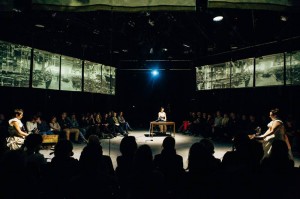 In the end, all of these contributions coalesce and blur together so it would be difficult to draw clear lines between the different contributions as it would also be difficult to give no credit to the performers, costume designers, video artists, engineers, interns, administrators, and many not for profit arts organizations who contributed to the end result of the work. But mostly I need to thank Erica and Fides, for putting up with my moods, having patience with my process (and my occasional lack of patience for theirs) and for putting so much effort and giving so much of themselves to a work that I hope will live far beyond the Krakow premiers we just had and Chicago premiers we have coming up.
In the end, all of these contributions coalesce and blur together so it would be difficult to draw clear lines between the different contributions as it would also be difficult to give no credit to the performers, costume designers, video artists, engineers, interns, administrators, and many not for profit arts organizations who contributed to the end result of the work. But mostly I need to thank Erica and Fides, for putting up with my moods, having patience with my process (and my occasional lack of patience for theirs) and for putting so much effort and giving so much of themselves to a work that I hope will live far beyond the Krakow premiers we just had and Chicago premiers we have coming up.
—————————
3 Singers premiers January 22nd at the National Museum of Health and Medicine Chicago.
Get your tickets now on eventbrite!
https://www.eventbrite.com/e/3-singers-presented-by-erica-mott-productions-tickets-14759164057
